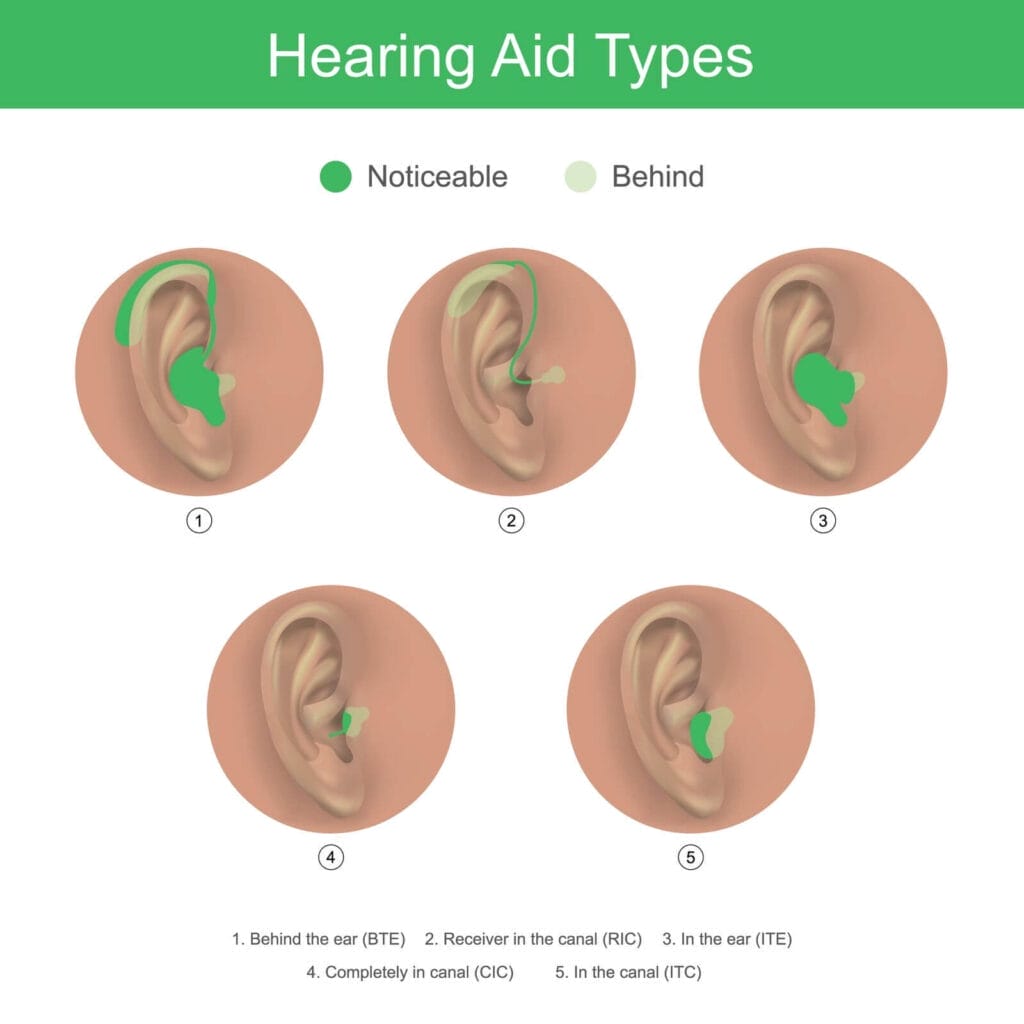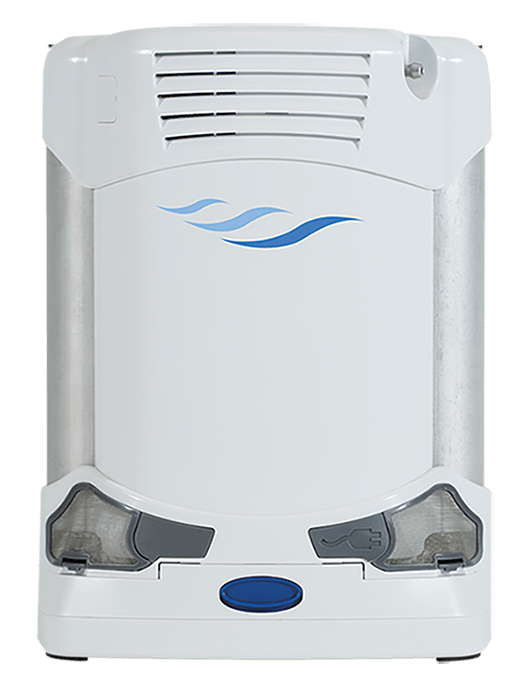
Once a person with hearing loss has made the potentially life-altering decision to get hearing aids, they have options to select a device that suits their level of hearing loss, cosmetic preferences, budget, and expectations. Choosing the right device is the first step to optimizing their hearing and returning to normal function. In this article, we discuss the available styles of hearing aids and the factors that should be considered when choosing between the different types.
Hearing aid styles
First, let’s look at the details of each hearing aid style to give you a better idea of your options.

Behind-the-ear (BTE)
This type of hearing aid includes a plastic appliance that clips behind the ear and is connected to a molded earpiece by a clear, discreet plastic tube. BTE hearing aids are appropriate for all levels of hearing loss, including profound. They are available with a wide variety of features, such as Bluetooth connectivity, choice of colors, and frequency modulation, a noise filter system. They are known for their versatility, power, and comfort, but they are the most visible type of hearing aid. They are also more likely to pick up wind noise.
BTE hearing aids may come equipped with a telecoil, a wire that acts as a wireless receiver and picks up sound in place of a microphone. Telecoils pick up sound from a hearing loop system, a type of assistive technology often used in public facilities. They eliminate the effects of background noise, distance, and other sources of interference. These systems allow people with telecoil-enabled hearing aids to better hear performances, lectures, and announcements in public places like theaters, lecture halls, and airports.
These devices are available over-the-counter (OTC), or they may be prescribed by a hearing professional.
Find the Best Hearing Aids For You!
Receiver-in-canal (RIC)
Sometimes referred to as a “mini-BTE,” this style of hearing aid is a smaller version of the BTE device. The appliance that clips behind the ear is smaller, and the connecting tube is narrower. The earpiece may be smaller or the same size as in the BTE version. A smaller earpiece has the advantage of reducing the likelihood of the occlusion effect, in which the earpiece completely blocks the ear canal so that the wearer’s voice is amplified inside their own head.
RIC devices are recommended for people with hearing loss that ranges from mild to severe but are not for those with profound hearing loss.
RIC devices are generally more comfortable and cosmetically appealing than their BTE counterparts. They also provide superior sound quality because they deliver sound by an ear wire that sits close to the eardrum, and they may come with telecoils. RIC devices are available OTC and by prescription.
In-the-ear (ITE)
These devices contain all the hearing aid parts in a single apparatus that fits snugly into the outer ear. These can be equipped with more advanced microphones and volume controls than the smaller canal hearing aid options. However, they are more visible. They are suitable for mild to severe hearing loss.
ITE devices may have a telecoil. They are available OTC or by prescription. Prescription ITE hearing aids can be custom molded for the wearer, whereas the OTC devices come in different sizes so the user can choose the best fit.
Canal hearing aids
Canal hearing aids are molded to fit securely in the ear canal. There are two types: in-the-canal (ITC) and completely-in-canal (CIC). Canal aids are only appropriate for people with mild to moderate hearing loss because their small size limits their power and volume.
Canal aids usually do not come with a telecoil because of their compact size. Their size can also make them difficult to adjust and manipulate for people without nimble hands. They are, however, the most discreet hearing appliances.
Canal aids are available by prescription only. There are two styles of canal aids:
- In-the-canal (ITC): This style of hearing aid is a type of canal aid in which the device is molded to fit securely in the ear canal. It may be visible to others.
- Completely-in-canal (CIC): These are similar to ITC devices but are seated more deeply in the ear canal, making them less likely to be visible to others.
Choosing the right hearing aid style
Each of the five styles of hearing aids has advantages and disadvantages. Choosing the right hearing aid is a personal and individualized process. Factors that may affect style choice include the degree of hearing loss, cosmetic preference, cost, and the person’s ability to manipulate and adjust the device. Here are some details of what to consider when choosing a hearing aid.
Aesthetic appearance
Depending on the person’s degree of hearing loss, they may be able to choose from all the available hearing aid models. Some people may prefer to wear one of the more discreet options, while others may not have such a preference.
Degree of hearing loss
Different types of hearing aids can address different levels of hearing loss. The degree of hearing loss may dictate which kinds of hearing aids are most appropriate, particularly in individuals with profound hearing loss, as certain types of hearing aids are not suited for this level of hearing loss.
Financial considerations
Financial considerations when choosing a style of hearing aid include the cost per pair, whether a warranty is available, and whether financing is available. It’s also important to consider whether hearing aids are covered by health insurance. Although original Medicare does not cover hearing aids, some Medicare Advantage plans, Medicaid in certain states, and other insurance companies offer some coverage of hearing aids.
The reputation of the hearing aid brand may also be a factor for some individuals who wish to ensure they are getting a reliable, quality device that will last.
Whether the hearing aids are available OTC or by prescription only will affect the cost. OTC hearing aids are typically less expensive than prescription hearing aids. They also do not require several visits to an audiologist, which can affect the overall cost.
Technical features
Technical aspects may play a role in device selection. For example, some people may prefer that their hearing aids have Bluetooth capability. A Bluetooth-enabled hearing aid allows the wearer to adjust the volume and other settings from their smartphone rather than by using dials on the device. Some Bluetooth hearing aids even allow streaming from a smartphone so the wearer can take phone calls, listen to music, or listen to the audio from videos through their hearing aid.
Some individuals may decide that having a device with a telecoil is important to them. This feature opens access to the increasing number of hearing loop systems available at theaters, airports, classrooms, restaurants, and other public venues.
Whether the device uses replaceable or rechargeable batteries is also a factor for some, depending on the individual’s preference and budget.
Lifestyle
The individual’s lifestyle, including when and where they will primarily use the hearing aids, can affect their decision. People who mostly stay at home and socialize in quieter places with small groups may only need a more basic hearing aid, while those who are frequently in busy, noisier locations may want to consider a higher-end model.
Choosing the right hearing aid style is an individual decision
Hearing aids are not a one-size-fits-all device. There are many options to consider when choosing the device that will offer the most satisfying and functional hearing support. An audiologist or other prescriber familiar with these devices or the staff at a hearing aid dispensary can offer advice and answer questions. Choosing a brand that offers a trial period is a great way to ensure satisfaction.








